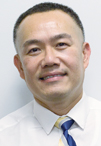By BETSY TAYLOR
The Anaheim Union High School District in Anaheim, Calif., is focusing on mental health education, screening and early intervention to link students to mental health treatment before anxiety or another cause of emotional distress escalate into a behavioral health crisis. The effort teaches adults to recognize and intervene with adolescents experiencing mental health issues, and it teaches students to improve their coping and communication skills.

School social worker Monique Nguyen meets with students in the Anaheim Union High School District in Anaheim, Calif. Her position is supported by grant funding from Providence St. Joseph Health and the Well Being Trust, a mental health foundation.
The school district's efforts are supported by a grant from Providence St. Joseph Health and the Well Being Trust, a mental health foundation created and funded with an initial $100 million endowment as part of the 2016 merger of Providence Health & Services and St. Joseph Health. As a condition of the merger, state regulators in California required the new health system to invest $30 million over three years in their markets in California to improve mental health services and address root causes of behavioral and mental health disorders.
In July 2017, Providence St. Joseph Health and the Well Being Trust announced the first round of California grants. The $10 million distribution included about $580,000 aimed at student mental health, a grant to be administered through Irvine, Calif.-based, St. Joseph Hoag Health. That 18-month grant, which runs through the end of this year, supports an initiative in the Anaheim Union High School District to improve adolescent mental health by equipping teachers, parents and students with tools to recognize and address mental health issues.
It funds behavioral health training and materials for parents, teachers and administrators and students. It also has allowed for some expansion in the numbers of clinical social workers in the district.
Identifying needs early
The National Alliance on Mental Illness says mental health conditions are common among teens and young adults. It says one in five live with a mental health condition, with half developing the condition by age 14 and three-quarters by age 24.

Chau
Dr. Clayton Chau is the Southern California regional executive medical director for Providence St. Joseph Health and its Institute for Mental Health and Wellness. He said the intent of the mental health initiative in the Anaheim school district is to provide care to children before their conditions escalate.
Chau, citing numbers from the district, said that in 2015-16, on average one student a week in the Anaheim district was placed on an involuntary, 72-hour psychiatric hold — an indication of acute mental illness. In the 2017-18 school year, 194 students were placed on psychiatric hold in an inpatient institution, Chau said.
Chau said that since the district began in 2017 its comprehensive efforts to facilitate access to mental health services and to educate parents and teachers to recognize signs that a child may be struggling with mental health issues, referrals to school district social workers have been strong. In the 2017-18 school year, school district social workers received 2,453 referrals from faculty or students' guardians.
Of the students referred for evaluation in the last school year, 1,800 had experienced a significant trauma. A suicide risk assessment was conducted for almost 80 percent of the students referred to district social workers for an initial mental health evaluation.
Teachers and parents who have concerns about the behavioral health of a student can request that the student have an initial screening by a social worker with the district. Based on the assessment, social workers link guardians and students to appropriate care: an emergency room in a crisis, or to a mental health clinician in the community for outpatient therapy for depression, substance abuse, abnormal behavior or other issues. The district's social workers also run therapeutic groups in the schools and do short-term counseling.
Chau said it's not enough to identify students in need of mental health counseling and treatment. Part of the work in the district relates to eliminating stigma and helping families overcome barriers to care, such as helping them identify a counselor or clinician their insurance covers, or services they can afford to pay for out of pocket.
Actionable information
The school district has about 30,000 students in seventh through 12th grades at 19 school locations, said Adela Cruz, the district's coordinator of school mental health. Cruz said when she was hired in 2010, the district had one licensed clinical social worker — "me, myself and I."
She has worked with social work graduate students interning with the district to harden counts of homeless children and foster children — at-risk groups that can require greater social supports at school.
Cruz said getting that actionable information about service demand to school administrators and the school board helped make the case that the district required more licensed clinical social workers to care for the thousands of students who needed more social, emotional or mental support. With improved data and funding support from the Well Being Trust grant and the district, the district now has 13 social workers. Most are licensed; some are working on completing their licensing requirements.
Open communication
Social workers, through a train-the-trainer approach, offer school district professional development sessions for teachers and administrative staff, teaching communication strategies and ways for teachers to handle their own stress, improve their self-care, avoid burnout and be a supportive presence for emotionally struggling students. In group educational sessions with parents and guardians scheduled before or after the school day, social workers also teach ways to open lines of communication with adolescents and discuss the differences between normal and abnormal behavior in young people.
"What we needed was to focus on the student/teacher relationship and the parent/child relationship when it comes to mental health," Cruz said.
Cruz said the district is developing peer-to-peer support groups, where students talk about their challenges and support each other in making healthy choices and avoiding risky behaviors. Chau said the approach develops leadership, communication and coping skills, and may encourage students to pursue careers in mental health professions.
One example of this is the MPOWRD program, a youth support group that builds leadership and communicating skills, including active listening.
Parent involvement
Patricia Thunyakij became worried when her son, a student in the district, seemed to lose motivation and self-confidence related to school.
She attended one of the district's educational behavioral health sessions for families. She said the meeting was packed with people seeking information. Following the program, Thunyakij shared her concerns about her son with Cruz. Cruz linked the Thunyakijs to a school social worker, and Thunyakij said she realized she was pushing her son too hard. The 16-year-old transferred to a different school in the district and Thunyakij made a conscious effort to lessen the pressure and scrutiny she placed on him.
The school district's mental health initiative and focus on overall student well-being led to improvements in her family's home environment. Now her son is doing much better overall and working to keep his grades up. "This is the kind of program we need," she said.
Copyright © 2018 by the Catholic Health Association
of the United States
For reprint permission, contact Betty Crosby or call (314) 253-3490.